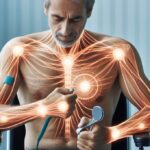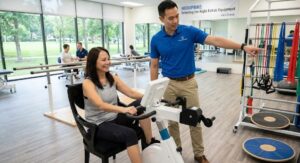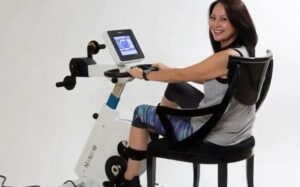
Muscular diseases, also known as neuromuscular disorders, affect the muscles and/or the nerves that control them. These conditions can lead to weakness, muscle wasting, and problems with movement. Therapy for such disorders are essential to improve mobility function or slow down their degenerative progression.
Muscular Diseases and Beneficial Therapy
Muscular diseases include the following:
- Muscular Dystrophy (MD): This is a group of genetic disorders characterized by progressive muscle weakness and degeneration. Duchenne muscular dystrophy and Becker muscular dystrophy are two common types.
- Amyotrophic Lateral Sclerosis (ALS): Also known as Lou Gehrig’s disease, ALS is a progressive neurodegenerative disease that affects nerve cells in the brain and spinal cord, leading to muscle weakness and eventually paralysis.
- Spinal Muscular Atrophy (SMA): SMA is a genetic disorder that results in the loss of motor neurons and progressive muscle wasting. It can range from mild to severe, with the severity depending on the type of SMA.
- Myasthenia Gravis: This is an autoimmune disorder that affects the neuromuscular junction, leading to muscle weakness and fatigue. It often affects the muscles that control eye and eyelid movement, facial expression, and swallowing.
- Charcot-Marie-Tooth Disease (CMT): CMT is a hereditary neuropathy that affects the peripheral nerves, leading to muscle weakness and atrophy, particularly in the legs and feet.
- Polymyositis and Dermatomyositis: These are inflammatory myopathies that cause muscle inflammation and weakness. Dermatomyositis also involves skin rashes.
- Friedreich’s Ataxia: This is a genetic disorder that affects the nervous system and leads to progressive damage to the spinal cord, resulting in muscle weakness and loss of coordination.
- Limb-Girdle Muscular Dystrophy (LGMD): LGMD is a group of genetic muscle disorders that primarily affect the muscles around the shoulders and hips.
- Mitochondrial Myopathies: These are a group of disorders caused by dysfunctional mitochondria, affecting the energy production in cells and leading to muscle weakness.
- Inclusion Body Myositis (IBM): IBM is an inflammatory muscle disease that causes progressive muscle weakness and atrophy, especially in the muscles of the fingers, wrists, and quadriceps.
It’s important to note that muscular diseases can vary widely in their symptoms, progression, and impact on daily life. If you suspect you or someone else may have a muscular disease, it’s crucial to consult with a healthcare professional for a proper diagnosis and management plan. Treatment regimens may vary, yet advanced technology in cycle therapy shows significant promise.
The Benefits of Active-Passive Cycle Ergometer Use in Muscular Disease Therapy
Active-passive cycle trainers and ergometers are devices designed to provide both active and passive modes of exercise. These devices can be beneficial for individuals with muscular diseases in several ways:
- Low-Impact Exercise: Muscular diseases often result in muscle weakness and fatigue, making high-impact exercises challenging. Active-passive cycle trainers typically offer low-impact exercise options, allowing individuals to engage in physical activity without putting excessive stress on their muscles and joints.
- Range of Motion (ROM) Improvement: Many muscular diseases can lead to a reduced range of motion in joints. The active-passive cycle trainer allows users to pedal actively, promoting joint movement and helping to improve or maintain flexibility and range of motion.
- Muscle Strengthening: The active mode of these devices allows users to actively engage and strengthen their muscles. This can be particularly useful for individuals with conditions like muscular dystrophy, where maintaining muscle strength is crucial to slow down the progression of muscle wasting.
- Passive Mode for Recovery: The passive mode of these devices enables users to let the machine move their limbs, providing a form of passive exercise. This can be beneficial for individuals who may have limitations in actively moving certain muscle groups. Passive movement can also aid in improving circulation and preventing stiffness.
- Customizable Resistance: Many active-passive cycle trainers come with adjustable resistance settings. This feature allows users to tailor the intensity of their workout to their specific needs and abilities, accommodating a wide range of fitness levels.
- Monitoring and Tracking: Some modern active-passive cycle trainers come equipped with monitoring and tracking features. This can be helpful for individuals and their healthcare providers to monitor progress, track performance, and make informed adjustments to their exercise regimen.
- Institutional (Hospital & Rehabilitation) Rehabilitation: Hospitals, adaptive training rooms, clinics and long term care centres can offer patient-client advanced therapy and benefits in-house.
- Home-Based Rehabilitation: Having a device like an active-passive cycle trainer at home provides individuals with the convenience of regular exercise without the need to travel to a gym or rehabilitation center. This can be especially important for those with limited mobility.
It’s important to note that qualified rehabilitation specialists can determine how the use of active-passive cycle trainers may benefit patients. Often, it relates to the specific nature and stage of the muscular disease. Individualized recommendations should be made before incorporating any new exercise equipment into a routine. Breakthrough equipment, like the MedUp V2 active-passive trainer, can potentially provide superior results to conventional therapy to support increased patient mobility.





